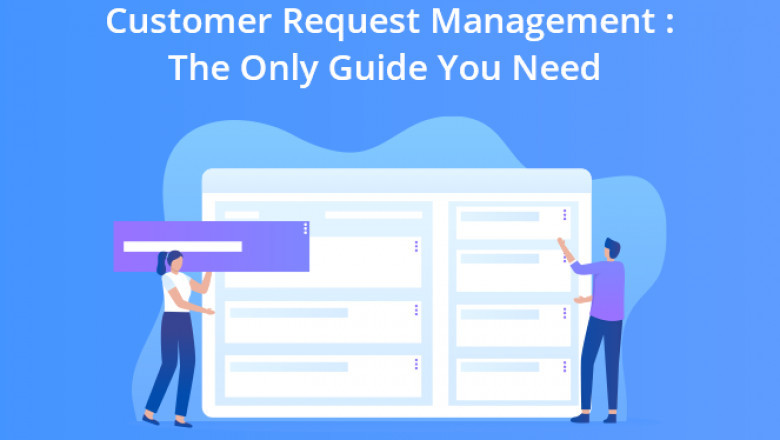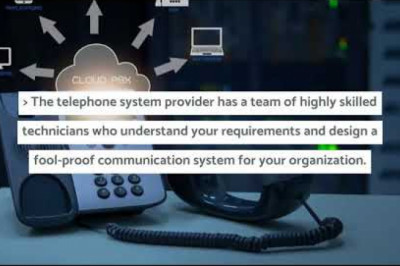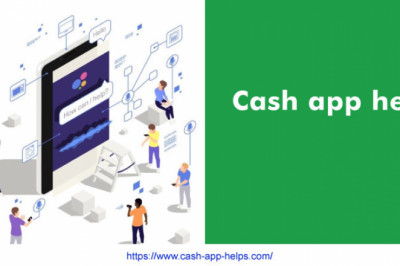views

Phones and the internet have made almost every piece of information available to customers at their fingertips. Customers can always find an apparent solution using the right communication channel. The speed of the solution is based on the complexity and urgency of questions.
The support department of companies will always go in a million different directions at once. Maybe there is a website error, or your network is running too slow again, you’re receiving too many queries at the same time, or maybe there’s a glitch preventing the payment processing at the user-end. Your support agents won’t have the time to solve more significant issues because they’re probably stuck in the daily here-and-now problems.
Businesses that excel at the customer experience drive revenues 4% to 8% higher than those of their market.
Employees need to provide a speedy resolution, to manage service requests successfully. They also need to keep the customer involved. Though requests can vary widely, the goal remains the same, i.e., to fulfill the request. All this while ensuring a positive customer experience. It is why streamlining your business’s customer request management process becomes inevitable.
Customer request management is a critical component of the support framework. It involves managing workflows and processes that are not repeatable. It includes various support tasks and activities. This article will go over the basics of customer request management and how it can benefit your business. Here’s a gist of what we’ll discuss:
What is Customer Request Management?
Customer request management refers to managing the lifecycle of activities linked to the fulfillment of support requests made by customers and other stakeholders. A dynamic solution equips the customers to register queries easily. It also helps support teams to streamline the fulfillment of customer requests.
Customer service request management is needed in nearly every area of a business, including:
- Finance
- Human Resources
- IT and Software Industry
- Education
- Retail and Ecommerce
- Medical Industry
- Manufacturing Industry
How Does Customer Request Management Work?
A customer request typically goes through the following processes:
- Customers who face queries contact the enterprise’s help desk to log/register their requests. They can do this through various communication channels (phone call, email, social media, chatbots, self-service, etc.)
- The query is then assigned to an agent on the support end. It could be based on priority, expertise, or any other support parameter.
- The support agents will then verify the relevant details and start with the resolution processes.
- After resolution, agents will close the ticket or query request.
- If the situation demands them to initiate an action with another department, they can log (assign) it from the help desk and pass it to the pertinent department.
- The concerned department can then act on the request and perform offline activities.
- Afterward, they can either close the request or pass it on to verify with the customer and close the issue.
- There may or may not be a third-party involvement in the request fulfillment.
- This entire activity takes place within a defined SLA timeline as per the company policy. Any delay in action can result in aggravated customers.
If your support team undergoes all the tasks mentioned above manually, it may wreak havoc on your support teams. A well-built customer request management system can help you streamline all your processes. To get customer request management right, you’ll need to focus on a broader vision of what a good customer experience means for your business. A flexible tool like DeskXpand can help your team cut through the chaos and configure workflows that easily fit your team. Take a look.
Why is Customer Request Management So Important?
A study conducted on American customers states that:
Almost one-third of consumers would consider switching companies after just one instance of a bad customer support experience. Besides, most Americans have decided not to go through with the further purchases because of a poor customer service experience.
On the other hand, another survey states that:
67% of customer churn is preventable if firms resolve issues the first time they occur.
These stats directly reflect how important customer request management is. Besides that, here are three primary reasons why companies need a customer request management system in 2021:
1. Consolidates the Data
Every day, every organization generates a considerable volume of complaint-related data. With so many incoming queries, it is easy to miss critical pieces of information in the process. Plus, there is a constant threat to data storage.
A customer request management system will store all your data in segments. With all data in one place, the data is easily accessible and secure. This way, agents will have to spend very little time looking for critical information like tasks, lists, notes, descriptions, deadlines, etc.
2. Increased Workflow Productivity
Increasing your workflow productivity will directly reflect your customer satisfaction rates. And customer satisfaction directly impacts customer retention rates. Hence, if your workflow productivity increases, it results in higher profits.
Investments in customer request management systems mean you’re investing in the future. It will help your team improve their productivity through multiple features. A self-service features can reduce your tickets by a significant amount. Robust ticketing features will make sure that you do not miss even a single query. A help desk updates your communication, reminds you of your tasks, and ensures that you meet deadlines. Nothing falls through the cracks.
3. Reduce the Error Margin
It is hard to make sure that you meet every timeline with manual or spreadsheet-based customer support. Manual systems call for tons of mistakes and flaws in the workflow. For example, your notes can get lost, and you may face data security issues, or issues with incorrect information while documentation, etc.
With a proper system in place, you can collect all essential information and ensure its security. The software will ensure that everyone follows the deadline and that the customers receive day-to-day updates regarding their queries.
4. Support Unification
Do you ever experience a chaotic situation if your customer support supervisor or agent is on vacation? Do things fall apart in their absence? This is exactly what a customer request management system prevents from happening.
It consolidates the entire support so that you’re able to access and retrieve data from a single place. So, in the absence of a particular agent, you can re-assign the tickets and maintain the flow of your SLAs.
Challenges in Customer Request Management?
Some of the challenges that companies across the globe face while managing customer requests are:
The biggest challenge is managing diverse channels and multiple touchpoints from different places. The support reps have to juggle multiple tools of communication to get it right.
- Teams find it difficult to unify all customer information in one place. It ensures fast response and enables customer satisfaction.
- It is also challenging to maintain the SLA timelines irrespective of complex queries.
- Maintain flexible support to allow a faster addition of new service requests.
- Implement linked process flows since organizations grow and introduce new products and services constantly.
How Help Desk Improves Your Request Management Process
Organizations face multiple challenges constantly, despite utilizing a plethora of solutions. Following are four ways how a help desk can benefit businesses to overcome these challenges:
1. Prioritize Your Customers
A help desk will help you focus your energies on the most critical and high-priority requests. You can then distribute available resources based on the usage and customer feedback. A help desk enables you to provide an easy-to-find, intuitive self-service portal as well.
A centralized, searchable knowledge base will provide easy access to common problems and answers. It makes your support more customer-centric and allows them to find information whenever they need it. By making the request fulfillment process customer-centric, you’ll be able to speed up resolutions and minimize the overall costs. A help desk also:
- Provides an intuitive and customer-centric interface
- It helps you offer a comprehensive knowledge base
- It creates a single point of contact for complete access to service requests.
2. Leverage Standardization and Automation
Businesses can adapt existing processes or define new ones to drive standardization and simplification to meet resolution. Standardization makes sure that your customers receive a consistent experience every time they reach out to seek support. It will improve overall support quality and efficiency. Support agents can also combine similar requests.
Business owners or support admins can also leverage automation features to address repetitive tasks like follow-up communications, updates on estimated resolution time, query registration and assignment features, and knowledge base recommendations. Automation features can also free up your staff to concentrate on delivering projects with more significant value to your customers.
3. Unify Your Support
Admin managers can unify their support workflows through help desks. A help desk enables you to document all the service requests (customer data, SLA requirements, analytics, approval process, etc.) from a single interface.
It enables you to solve customer requests while viewing everything you need in one place. You can view everything on a unified dashboard and then guide your team and operations accordingly. It allows your team to collaborate on critical issues quickly. Think how easy your support agent’s life would become if they could chat within the ticket when they needed to collaborate.
72% of consumers see having to explain their problem to multiple agents/support reps as poor customer service.
Omnichannel features bring together all the queries from the support channels. These queries from various channels (phone, email, chatbots, social media, etc.) are converted into a ticket and assigned to the agents according to the SLAs. Hence agents do not have to juggle multiple tools to address the issue and bring resolution. With a unified interface, teams can:
- Manage data and maintain the SLAs easily
- Provides employees with a 360-degree view of the query
- Enables admin to monitor everything from a single place
- Enables multi-channel and omnichannel communication
- Agents can have the data and resolution at their fingertips
- Data security is maintained
Since we’re talking about unification, DeskXpand is a help desk that brings everything together in a single interface. It is a robust omnichannel customer request management software built by ISO-certified professional developers with 14+ years of development experience. Find out more about DeskXpand.
4. Provide Visibility
Your customers deserve to know status updates throughout their resolution journey. These updates include confirmation of request receipt, updates on their query, which agent is resolving their query, updates on the timeline, and so on.
Besides this, a help desk can help you improve visibility of your support by creating a dashboard and reports. The analytics and reporting features can help you identify the trends and roadblocks that can alleviate the need for specific processes and tasks too complicated or insufficient.
You can track resources, employee assignments, associated costs, quality of delivery, and customer feedback.
Advantages of Help Desk Software
Customer request management is an operating arm of an organization. It is designed to keep operations running smoothly. The help desk handles everything from individual tech support to providing a seamless medium for organizations to deliver. Here are some key advantages of help desks:
- It standardizes your entire workflow and procedures enabling you to provide a consistent experience.
- Help desks make things easier for the end-users. Anyone can create a service request simply by filling a form or registering through multiple mediums of communication.
- Efficiency. The more you automate your manual tasks, the more likely you will reap their benefits.
- The help desk eliminates the possibility of manual errors
- and keeps the processes moving quickly to completion.Help desks provide a 360-degree insight to the support managers. With consistent processes and centralized information, teams can more efficiently control the request statuses and identify potential bottlenecks.
The Article is Originally Published On:
https://www.deskxpand.com/blog/guide-to-customer-request-management/












